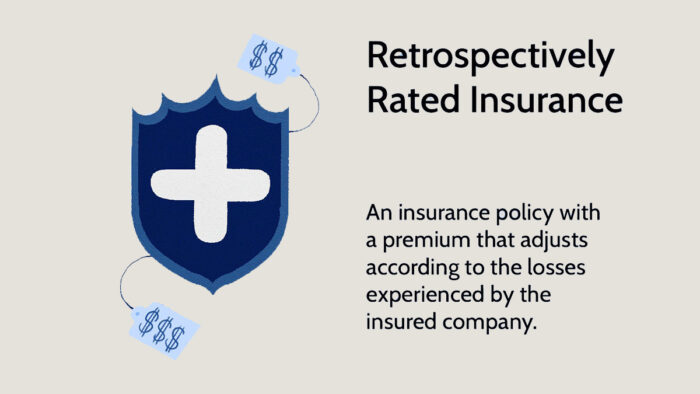Retrospectively rated insurance is a unique insurance arrangement where the premium is not fixed but instead fluctuates based on the actual losses suffered by the insured organization. Unlike traditional insurance models that rely on industry-wide loss data to set premiums, this approach tailors the premium to reflect the specific loss experience of the policyholder.

Initially, a base premium is established, and adjustments are made periodically after the policy term concludes, taking into account the actual losses incurred during that period.
One of the distinguishing features of retrospectively rated insurance is its direct correlation between premium adjustments and the real losses experienced by the insured entity. This dynamic nature of premiums can either benefit or disadvantage the policyholder, depending on their loss history.
Consequently, organizations under such policies are incentivized to enhance safety measures and implement effective loss controls to mitigate losses and prevent premium escalation. Retrospectively rated insurance finds practical application in various areas such as workers’ compensation, general liability, and auto liability, offering a tailored approach to risk management that differs significantly from conventional premium calculation methods.
How Does Retrospectively Rated Insurance Work?
Retrospectively rated insurance policies typically commence with premiums based on anticipated losses, which are later adjusted upon the policy’s expiration to reflect the actual losses sustained throughout its duration.
This approach acts as an incentive for the insured organization to manage its losses effectively, as successful risk mitigation can lead to a reduction in policy costs. Premium adjustments are typically constrained within a specified range, with set minimum and maximum premium amounts.
When organizations assess their insurance options, they balance the level of risk they are willing to assume against the premium they are prepared to pay. Higher risk coverage correlates with increased premiums. In certain scenarios, companies may opt to retain more risk while considering a retrospectively rated plan that allows for premium adjustments over time.
Businesses utilizing retrospectively rated insurance policies may apply them across various risk categories, including general liability, workers’ compensation, property, and crime. These plans can encompass multiple risks within a single policy, eliminating the need for separate policies for each risk type.
Typically, the risks covered have a low likelihood of catastrophic events but may result in frequent losses. The combination of high loss frequency and low loss severity contributes to the predictability of these losses.
What is a Retrospective Premium Adjustment?
A retrospective premium adjustment refers to the process within a retrospective premium policy where modifications are applied to the premium calculation, taking into account the historical loss data of the insured entity.
These adjustments can be conducted using two primary methods: the “paid loss” approach, which considers the actual losses that have been settled and paid out, or the “incurred loss” method, which involves assessing losses based on reserves established at the time a claim is recorded.
In a retrospective premium framework, the retrospective premium adjustment mechanism plays a crucial role in aligning the premium with the actual loss experience of the policyholder. By incorporating historical loss information into the premium calculation, insurers can ensure that the premium accurately reflects the risk profile and claim history of the insured entity.
This dynamic adjustment process allows for a more tailored and responsive premium structure, enhancing the fairness and accuracy of the insurance pricing model. Moreover, the flexibility inherent in retrospective premium adjustments enables insurers and policyholders to adapt to changing risk scenarios and optimize the cost-effectiveness of insurance coverage over time.
Exploring the Contrast Between Retrospective and Retroactive
Distinguishing between retrospective and retroactive statutes reveals a fundamental difference in their operational scope. A retroactive statute functions from the time preceding its enactment, essentially operating in reverse by altering the legal framework from its previous state.
On the other hand, a retrospective statute is forward-looking, impacting future outcomes while addressing past events. This distinction underscores the dynamic nature of legal provisions, where retroactivity delves into past occurrences to redefine legal implications while retrospectively focusing on shaping future consequences based on historical events.
FAQs
What is the difference between retrospectively rated insurance and experience-rated insurance?
Retrospectively rated insurance adjusts premiums based on actual losses during the current policy period, while experience-rated insurance involves adjustments considering previous policy periods. Current losses hold more significance in retrospectively rated policies, whereas experience rating calculates the experience modification factor, commonly associated with workers’ compensation insurance.
How does a retrospective premium adjustment work in retrospectively rated insurance?
In retrospectively rated insurance, a retrospective premium adjustment involves modifying the premium calculation based on the historical loss data of the insured entity. This adjustment can be made using the “paid loss” approach, which considers actual losses paid, or the “incurred loss” method, where losses are assessed based on reserves set at the time a claim is recorded.
What risks can be covered under a retrospectively rated insurance policy?
Companies purchasing retrospectively rated insurance can use it to cover various risks, including general liability, workers’ compensation, property, and crime. These policies can encompass multiple risks under a single policy, eliminating the need for separate policies for each risk type. Typically, the risks covered have a low probability of catastrophic events but may result in frequent losses.
Which companies are suitable for retrospectively rated insurance?
Not all companies are suited for retrospectively rated insurance. Companies with small premiums, those experiencing substantial premium fluctuations between policy periods, or those with unstable finances may not be well-suited for this insurance model. Insurers evaluate the risk profile of policyholders to determine suitability for retrospectively rated insurance.
How does a retrospective rating plan incentivize companies to control losses?
A retrospective rating plan, such as the one offered by Sentry, determines premiums based on recent claims history after each policy period. When managed effectively, this plan can incentivize companies to control losses by rewarding dedication to workplace safety. Companies can benefit from reduced premiums by demonstrating a commitment to risk management and loss control measures.



